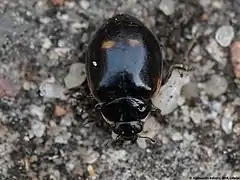| Ten-spotted lady beetle | |
|---|---|
.jpg.webp) | |
| Adalia decempunctata. Forma typica | |
 | |
| Larva of Adalia decempunctata | |
| Scientific classification | |
| Domain: | Eukaryota |
| Kingdom: | Animalia |
| Phylum: | Arthropoda |
| Class: | Insecta |
| Order: | Coleoptera |
| Infraorder: | Cucujiformia |
| Family: | Coccinellidae |
| Genus: | Adalia |
| Species: | A. decempunctata |
| Binomial name | |
| Adalia decempunctata | |
| Synonyms[1] | |
|
List
| |
Adalia decempunctata, the ten-spotted ladybird or ten-spotted lady beetle, is a carnivorous beetle of the family Coccinellidae.
The ten-spotted ladybird was one of the many species originally described by Carl Linnaeus in his 18th-century work, Systema Naturae, its original name was Coccinella decempunctata.[2] Its specific name from the Latin decem "ten", and punctata "spotted".[3]
Varietas
- Adalia decempunctata var. lutea (Rossi)
- Adalia decempunctata var. quattuorpunctata (Linnaeus)
- Adalia decempunctata var. octopunctata Müller
- Adalia decempunctata var. lateripunctata Gradl.
- Adalia decempunctata var. humeralis Schaller
- Adalia decempunctata var. guttatopunctata (Linnaeus)
- Adalia decempunctata var. decempustulata (Linnaeus)
- Adalia decempunctata var. bipustulata Herbst
Distribution
Adalia decempunctata is a common Palearctic species found in Europe, North Africa, European Russia, the Caucasus, Siberia, Belarus, Ukraine, Moldova, Transcaucasia and western Asia.[1][5][6]
Description
Adalia decempunctata can reach a body length of about 3.5–5 mm (0.14–0.20 in). This species is highly variable. Individuals may in fact have a red, orange or brown ground colour and between 0 and 12 distinct dark elytral spots, although rarely more spots have been recorded, up to 15 spots. These beetles have a glabrous body, with an almost round form. Legs and antennae are usually brown or orange.[7] The species includes eight varietas, with three basic forms. The light form shows five to seven black spots on the pronotum and several black spots on the red-orange elytra. The dark form is mainly black or brown in color, and the pronotum has a light border on the sides and front. The mixed form has black or brown in color elytra, each with five orange to red spots. Sometimes these ladybirds have no spots at all.
Biology
It occurs in western European broadleaf forests eastern deciduous forests, Sarmatic mixed forests, at forest edges, and in parks and gardens wastelands and in Eurasian Steppe, Pannonian Steppe biotopes. It is found on bushes and deciduous trees, on grasses, under bark, in moss on trees, in leaf litter, on brushwood, coarse woody debris and in alluvial soil.[8]
The insects feed on aphids on trees and bushes.[9] The adults overwinter in litter and among fallen leaves.
Gallery
_-_f._decempunctata_-_Flickr_-_S._Rae_(3).jpg.webp) Adalia decempunctata decempunctata
Adalia decempunctata decempunctata_Cumnor.jpg.webp) Adalia decempunctata var. bipustulata
Adalia decempunctata var. bipustulata_(26753783571).jpg.webp) Adalia decempunctata var. octopunctata
Adalia decempunctata var. octopunctata Adalia decempunctata var. guttatopunctata
Adalia decempunctata var. guttatopunctata.jpg.webp) Dark variant
Dark variant.jpg.webp) Unusual form
Unusual form Unusual form
Unusual form Unusual form
Unusual form
References
- 1 2 Fauna Europaea
- ↑ Linnaeus, C. (1758). Systema naturae per regna tria naturae, secundum classes, ordines, genera, species, cum characteribus, differentiis, synonymis, locis. Tomus I. Editio decima, reformata (in Latin). Holmiae. (Laurentii Salvii).
- ↑ Simpson, D. P. (1979). Cassell's Latin Dictionary (5 ed.). London: Cassell Ltd. ISBN 0-304-52257-0.
- ↑ Biolib
- ↑ N. B. Nikitsky and A. S. Ukrainsky, 2016 The Ladybird Beetles (Coleoptera, Coccinellidae) of Moscow Province ISSN 0013-8738, Entomological Review, 2016, Vol. 96, No. 6, pp. 710–735 ISSN 0013-8738 online pdf
- ↑ GBIF
- ↑ Watford Coleoptera Group
- ↑ Koch, K., Die Käfer Mitteleuropas, Ökologie. Vol. 2 (Goecke und Evers Verlag, Krefeld, 1989).
- ↑ Savoiskaya, G. I., Coccinellid Larvae (Coleoptera, Coccinellidae) of the Fauna of the USSR (Nauka, Leningrad Branch, Leningrad, 1983) (Keys to the Fauna of the USSR, Published by the Zoological Institute of the Academy of Sciences of the USSR, No. 137) [in Russian].